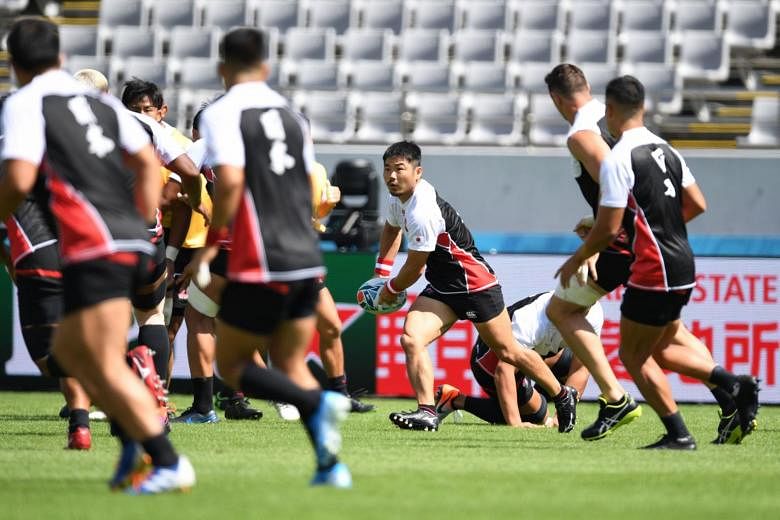TOKYO (BLOOMBERG) - On pristine sports fields in north-eastern Japan, the Argentine men's rugby team practised their scrums, line-outs and set plays in the sunshine, in preparation for their opening game against France this week in the Rugby World Cup.
About a year ago, the ground beneath their feet was covered with parking spaces for the hundreds of workers who had to contain and then clean up the world's worst nuclear disaster.
Eight years after the earthquake and tsunami that caused the meltdown of the Fukushima Dai-ichi reactor, the only sign of the devastation at the J-Village sports complex is a radiation monitor showing levels lower than in Tokyo.
But residents and businesses in the region are still struggling to persuade the world that their towns and produce are safe.
"It has been eight years," said Ms Saiko Koizumi, 48, a resident of Iwaki, Fukushima. "We drink water out of the taps and have moved on from the life in the immediate aftermath. But outside, the image of Fukushima remains."
At the centre of that scepticism is Tokyo Electric Power Company (Tepco), the firm that ran the doomed reactor and was for years lambasted by the public and media for its response to the disaster.
Tepco rebuilt the training ground Argentina's Pumas were using to practise and donated it to the local prefecture, one of the finest such facilities in the country.
The company set up an office to promote local products such as wine and established a communications board to allay public fears about radiation.
In the years following the accident, the power company has spent more than US$8 billion (S$11 billion) on recovery and decommissioning of the four affected reactors at the plant.
"That doesn't substitute for true atonement," said Ms Saki Okawara, 67, a local anti-nuclear activist who is trying to restore business for her brother's organic farm. "I don't believe the people of Fukushima trust Tepco."
Tepco says it wants to help restore the region's image.
Before the accident, Fukushima was known in Japan for its abundant seafood and fresh fruit, including its famous peaches. Hikers and skiers flocked to its mountains and cattle farms raised its prized Black Cattle.
"We have a responsibility for the accident and a responsibility for decontaminating the plant and the area. That responsibility involves compensation, damages and the revitalisation of the local society and economy," Tepco said in a statement. It did not comment on the use of J-Village for the Rugby World Cup.
But Tepco has its own image to worry about. While Prime Minister Shinzo Abe wants the utility to fire up other nuclear reactors that were shuttered after 2011, many in the public say they cannot trust it with that responsibility.
Meanwhile, neighbour South Korea is raising concerns over potential contamination of the ocean from a planned release of processed water from the plant. Earlier this year, the World Trade Organisation upheld a South Korean ban on some Japanese seafood products that was introduced after the nuclear meltdown.
And on Sept 9, the company's image took another blow with criticism for its handling of a typhoon-triggered blackout in Chiba Prefecture next to Tokyo that left tens of thousands of households without electricity for over a week and prompted the government to call out its military to speed up what locals have said is an inadequate response.
The company also faces increased competition after Japan liberalised its power market in April 2016. Since then, Tepco has lost about 5.3 million customers.
None of those troubles compare to the shadow cast by Tepco's Dai-ichi plant. The clean-up is expected to take as long as 40 years and cost a total of about US$70 billion.
In July, Tepco said it will decommission four nearby reactors that survived the tsunami undamaged, at a cost of 282 billion yen (S$3.6 billion). That would reduce Japan's fleet of operable reactors to 33, from 54 before the disaster.
Tepco operated 17 reactors in Japan before the disaster and now has only seven operable plants. None are in service as it awaits local government approval to restart them.
The catastrophe in 2011 that haunts Tepco also continues to affect those who live around the stricken plant. For some, the rugby competition and the spotlight of international media may be a chance to help rebuild the region's image.
Except for the small exclusion zone by the reactor, life returned to normal in Fukushima Prefecture several years ago. But residents say the rest of the world still needs to be convinced that the area is not a nuclear wasteland.
Before the accident, J-Village was Japan's first national training centre for football. Opened in 1997, it hosted the Argentine men's national football team for the Fifa World Cup in 2002. With 11 new football fields, it is one of the best sports facilities in the country and next year, it will be the place where Japan's torch relay begins for the 2020 Summer Olympics in Tokyo.
Residents hope that publicity from those events will help. So far the rehabilitation they seek remains elusive. Food from the region is screened before going to store shelves, but a survey showed that about one in eight Japanese are still hesitant to buy products from the prefecture.
The problem is that J-Village is only about 20km from the Dai-ichi plant and 7km from the current exclusion zone. As workers and robots continue the long process of dismantling the reactors and decontaminating the site, even the world's athletes may struggle to undo the damage to a region that became synonymous with nuclear peril.
"Given the harm that has been done, I don't know if Tepco can ever make things right," Ms Okawara said.

